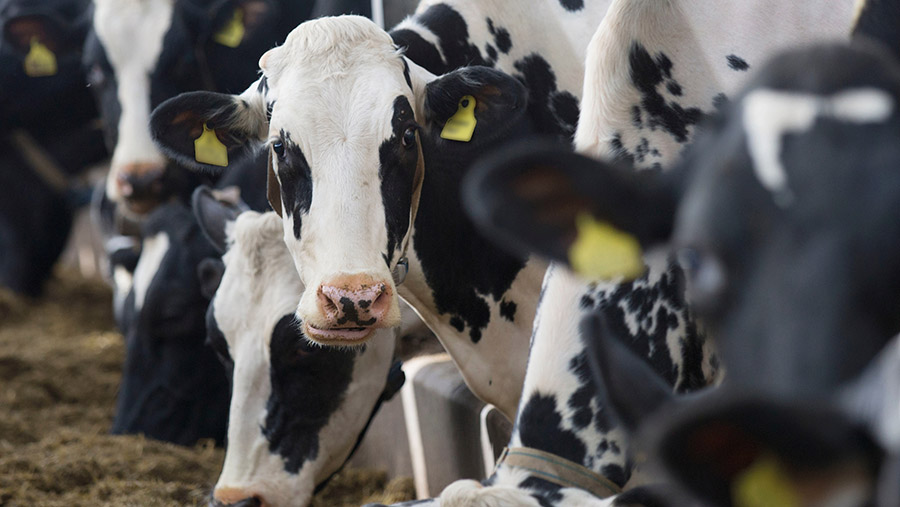Soaking concentrates lifts yield by 1.5 litres a cow a day
 © AHDB
© AHDB Scottish farmer William Baillie has increased milk yields by 1.5 litres a cow a day since making small changes to the diet of his dairy cows.
Soaking concentrates overnight – a strategy known as compact feeding – has been one instrumental change that has helped lift milk output in Mr Baillie’s 310-head herd of pedigree Holsteins at Hillhead of Covington Farm, Lanarkshire.
The idea came about after he joined AHDB’s strategic farm programme in 2018.
See also: What to consider when planning a compact calving system

William Baillie © AHDB
“I wanted to boost lifetime milk yields from 11,400 litres to 12,000 litres. I also wanted to improve our feeding strategy – largely, making the best use of concentrates, to optimise the herd’s performance,” explains Mr Baillie.
He worked alongside independent nutritionist Hugh Kerr to examine his feeding regime and see how any potential yield increase could be achieved.
Implementing compact feeding
From a ration component point of view, everything has stayed the same. However, the big difference is that concentrates are now soaked overnight.
“As a general guide, we add about two-thirds of a kilo of water for every kilo of concentrate in the mix,” says Mr Baillie.
Once the last mix of the day is done and fed, the total concentrate requirement for the following day is loaded into the mixer wagon. Water is then added, the ration is mixed, and it is left to soak until the morning.
The next day the concentrates are emptied out of the wagon and the silage and wholecrop are loaded before the concentrates are added back into the wagon for a final mix before being fed out.
“The concentrates develop a mash-like consistency,” says Mr Baillie, adding: “We do on average three loads a day in the winter, so the concentrate mash is distributed equally between the loads.”
Generally, 12kg dry matter (DM) of forage is fed a head. This comprises 3-4kg wholecrop and the rest grass silage. About 9-10kg of concentrates are fed a head.
Benefits
“Compact feeding minimises sorting and makes every bite of the ration much more consistent,” he says.
As a result, we have seen increased intake, which has not only led to our 1.5 litres a head a day yield increases, but we have also noted an increase in milk solids.
Mr Baillie says these benefits outweigh any of the disadvantages associated with compact feeding.
But he admits the main challenge is largely the increased labour – it is an extra job to factor into the day and it undoubtedly takes more time.
“Getting the volume of water into the wagon has also proved to be a bit of a logistical task. Currently, we are running water from large tanks, and it is a slow way of getting it in.
“However, with an improved setup, this could be easily alleviated.”
Other diet changes
He has also tried tweaking the diet components slightly.
“The aim has been to make starch feeding as ‘rumen-friendly’ as possible and, as such, we now feed caustic soda-treated wholegrain wheat, as opposed to a rolled cereal.
“The theory behind this is that the larger wholegrain particle size improves digestion, as it takes longer to work through the rumen, while the caustic soda raises the pH to minimise the risk of acidity or inflammation in the gut.”
He also tried to increase the frequency of feeding to twice daily to increase intake, but says the difference was not significant enough to warrant the extra labour and has since gone back to feeding once daily.
Compact feeding – the science
The principles of compact feeding originated in Denmark, where the practice of soaking concentrates was first trialled to stop cattle sorting feed rations, says independent nutritionist Hugh Kerr.
“The biggest risk to any farmer or nutritionist when it comes to the ration is sorting – cows are very skilled animals at sorting the ‘good’ bits from the less favourable, but the result is that they end up with a very different intake to what has been prescribed.”
While there is lots of evidence to show that compact feeding can have a positive impact on intake – and subsequently milk yields – Mr Kerr says one of the barriers is the difficulty comprehending adding water to a dry ration.
“This is something that farmers just need to get confident with. If you think about grazed grass, for example, the average DM is 15%, which means it is 85% water – so why should you worry about adding water to the total mixed ration?”
The advantages of soaking concentrates go beyond just reduced sorting, he says. In fact, it can improve cow behaviour.
“Something we have observed from an animal behaviour point of view is that when food is wet, cows are more likely to eat bigger meals and eat faster.
“The combination of those two factors is increased intake and less time spent at the feeding/water trough. This results in more lying time and subsequently, increased milk yields.”
Soaking concentrates also helps feed utilisation, too. “As we challenge cows to produce more milk in the future, something we have to consider is rumen retention time.
“If a cow eats dry feed, she must go to the trough and drink to wet it in order to start the digestion process.
“If the feed is already wet it saves a bit of time, as it is ready to be digested and utilised sooner.
“If you are seeking higher yields, it is important to prioritise both intake and digestion.
“In scenarios where farms are implementing compact feeding well, I have seen yield increases of 2-3 litres a cow a day from the same diet.
“Here, it all comes down to physical nutrition, not chemical nutrition.”
